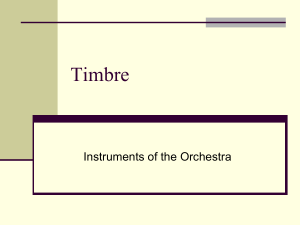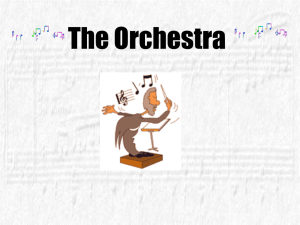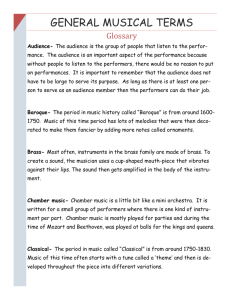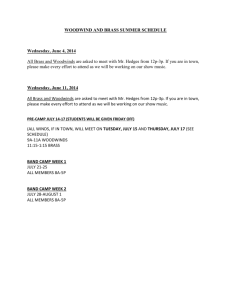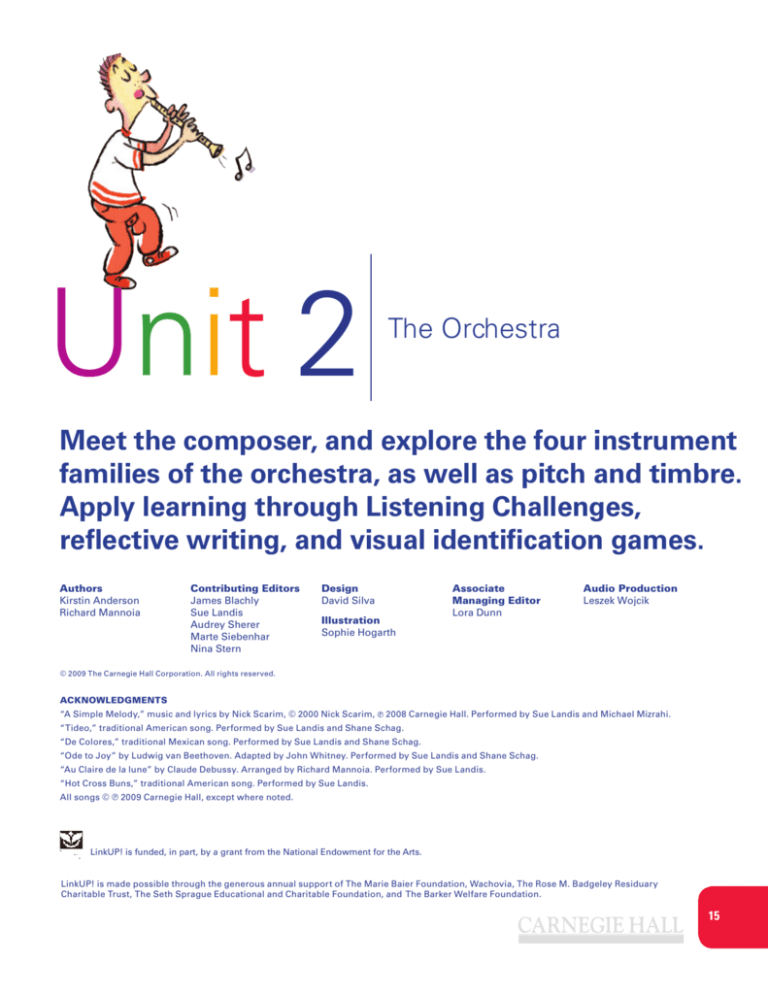
Unit 2
The Orchestra
| 27
Meet the composer, and explore the four instrument
families of the orchestra, as well as pitch and timbre.
Apply learning through Listening Challenges,
reflective writing, and visual identification games.
Authors
Kirstin Anderson
Richard Mannoia
Contributing Editors
James Blachly
Sue Landis
Audrey Sherer
Marte Siebenhar
Nina Stern
Design
David Silva
Illustration
Sophie Hogarth
Associate
Managing Editor
Lora Dunn
Audio Production
Leszek Wojcik
© 2009 The Carnegie Hall Corporation. All rights reserved.
ACKNOWLEDGMENTS
“A Simple Melody,” music and lyrics by Nick Scarim, © 2000 Nick Scarim,
2008 Carnegie Hall. Performed by Sue Landis and Michael Mizrahi.
“Tideo,” traditional American song. Performed by Sue Landis and Shane Schag.
“De Colores,” traditional Mexican song. Performed by Sue Landis and Shane Schag.
“Ode to Joy” by Ludwig van Beethoven. Adapted by John Whitney. Performed by Sue Landis and Shane Schag.
“Au Claire de la lune” by Claude Debussy. Arranged by Richard Mannoia. Performed by Sue Landis.
“Hot Cross Buns,” traditional American song. Performed by Sue Landis.
All songs ©
2009 Carnegie Hall, except where noted.
LinkUP! is funded, in part, by a grant from the National Endowment for the Arts.
LinkUP! is made possible through the generous annual support of The Marie Baier Foundation, Wachovia, The Rose M. Badgeley Residuary
Charitable Trust, The Seth Sprague Educational and Charitable Foundation, and The Barker Welfare Foundation.
15
Unit 2: The Orchestra
Elvis: Wow! The musicians in the orchestra are playing so many different
instruments. How are they organized?
Violet: My aunt knows all about the instruments, but I don’t think she can
help us since she’s about to start a rehearsal. But let’s keep looking for Gino,
the Carnegie Hall cat. He knows a lot about music.
Elvis: There he is!
Violet: Hi there. We’re Elvis and Violet, and we’re so happy you found Gino,
because we are curious about all those instruments. We heard Gino knows a lot
about music and can help us.
Composer: Well, Gino sure knows how to get people the answers they need!
I’m glad you’re asking about the instruments, because I spend a lot of time
thinking about them. I’m a composer, and I write music. When I’m working,
I’m always thinking about how the piece is going to sound.
lesson extension
16
unit 2
Have your students put their heads down and close their eyes. Then,
select three students and have them say the same word (for example,
“hello”). With their heads still down and eyes closed, have the other
students guess whose voice it is. Follow up with a discussion of
different vocal qualities (include movie or cartoon characters for
exaggerated examples) and generate descriptive language for
identifying vocal or instrumental sounds. Facilitate a sharing of
students’ reflections and experiences. [NYC 2]
Violet: Isn’t that why the orchestra is arranged the way it is—according to
the different ways the instruments make sound?
Composer: You’re right! The orchestra is divided into four different families:
strings, woodwinds, brass, and percussion. Take a look at this map to see
where they usually sit.
Timpani
Trombones
Bass Drum
Snare
Drum
Cymbals
French Horns
Clarinets
Harp
Piccolo
Trumpets
Tuba
Bassoons
Flutes
Oboes
| 27
Basses
Violas
Violins
Cellos
String Family
Woodwind Family
Brass Family
Percussion Family
Violet: Oh, I get it. The four instrument families all sit together onstage as one
big extended family.
Elvis: Yeah, but how can we tell which instruments belong to which family?
The seating arrangement of the instruments in the orchestra can vary
depending on the music being played or even the tradition of individual
orchestral institutions.
teacher note
unit 2
17
Help Elvis and Violet: What do the instruments in each family have in common?
WOODWINDS
BRASS
reflection discussion
18
unit 2
For the instrument family discussion, use these
example questions: What are the instruments
in each family made of? How are they shaped?
How are they played?
PERCUSSION
| 27
STRINGS
unit 2
19
The woodwind instruments look like long tubes with
lots of keys. Some have pieces of wood, called reeds,
that performers blow into to make sounds. Others, like
flutes and piccolos, have a hole across which players
blow to make sound. The brass instruments are made
out of metal and are curvy. Performers blow into them
through metal mouthpieces. The string instruments
are wooden and make sound when performers draw a
bow (a wooden stick that holds long strands of horsehair) across the strings, or pluck the strings with their
fingers. Percussion instruments have many shapes
and sizes, and they make sound when they’re shaken,
scraped, or struck.
Elvis: This is fun! The families are all so different and interesting in their own
ways. Let’s hear what they all sound like.
Violet: They all sound so beautiful and different. It’s kind of like each family has
its own voice.
Elvis: Yeah, but I wonder if I could still match the sounds with the instrument
families when I have my eyes closed!
Composer: Well then, here’s a Listening Challenge to help you find out if you can.
lesson extension
20
unit 2
Listen to each instrument family example several times.
With your students, brainstorm to come up with words
that describe the sound of each family. Chart students’
responses on chart paper or have them write their
thoughts down on paper.
reflective writing
listening challenge
How would you describe the sounds of the instrument families?
(Examples of these recommended works are available for download
from your favorite online music retailer.)
Woodwind Family
listen to The Final Fugue,
The Young Person’s Guide
to the Orchestra by Britten
Brass Family
| 27
listen to Canzon septimi toni
No. 2 by Gabrieli
Percussion Family
listen to Act 1, The Nose
by Shostakovich
String Family
listen to First Movement,
Serenade for Strings by
Tchaikovsky
unit 2
21
listening challenge
Examples of these recommended works are available for
download from your favorite online music retailer.
listen to
The fanfare from La Péri by Dukas
listen to
Concerto for Two Oboes by Albinoni
brass
woodwinds
listen to
Andante Cantabile by Tchaikovsky
listen to
Pas Redoublé No. 3 by Cherubini
listen to
Xylophonia by Joe Green
listen to
Adagio for Strings by Barber
strings
percussion
percussion
strings
For an even harder challenge, try identifying two families playing at once:
listen to
Fanfare for the Common Man by Copland
brass and percussion
listen to
The Moldau by Smetana
woodwinds and strings
Help Elvis and Violet identify the instrument families. Below are the names of the instruments.
Below each one, write down the name of the family each one belongs to.
1. clarinet
woodwinds
2. French horn
brass
22
unit 2
3. flute
woodwinds
4. xylophone
percussion
5. oboe
woodwinds
| 27
6. timpani
percussion
7. bassoon
woodwinds
8. violin
strings
9. trombone
brass
unit 2
23
10. tambourine
percussion
11. double bass
strings
12. piccolo
woodwinds
13. tuba
brass
14. triangle
percussion
15. snare drum
percussion
24
unit 2
16. cello
strings
17. trumpet
brass
18. viola
strings
| 27
Violet: That was pretty easy. I’m starting to notice that some instruments within
each family look bigger than the others.
Composer: That’s right. Each family has small and large instruments. The smaller
ones make higher sounds, and the bigger ones make deeper or lower sounds.
unit 2
25
Identify the instruments. Then sort them by size within their families
and label each instrument small, medium, or large.
String Family
Name:
Size:
violin
viola
double bass
small
medium
large
Brass Family
26
Name:
trumpet
tuba
French horn
Size:
small
large
medium
unit 2
Percussion Family
Name:
Size:
timpani
bongos
snare
large
medium
small
Woodwind Family
Name:
Size:
| 27
clarinet
bassoon
piccolo
medium
large
small
Composer: Let’s listen to the violin, the smallest and highest-sounding string
instrument.
listen to
Caprice for Solo Violin No. 24 by Paganini
(Examples of this recommended work are available for download from your favorite
online music retailer.)
unit 2
27
And now let’s hear the cello, a deeper sounding string instrument.
listen to
Allemande, Suite for Solo Cello No. 2 in D Minor by Bach (Examples of this recommended
work are available for download from your favorite online music retailer.)
Elvis: Wow, that’s such a big difference!
Composer: I’m glad you can hear that. In addition to highness and lowness,
each instrument has its own distinct sound quality, or timbre. Do this Listening
Challenge and see if you can identify a few more instruments by their timbres.
listening challenge
First, write down the name of the instrument family to which each instrument
belongs. Then, circle the instrument you hear in each example.
Do you hear a:
1.
listen to Track 1
flute
OR
woodwind
___________________
family
28
unit 2
bass drum ?
percussion
___________________
family
2.
listen to Track 2
trumpet
OR
brass
___________________
family
violin ?
string
___________________
family
| 27
3.
listen to Track 3
double bass
OR
string
___________________
family
oboe ?
woodwind
___________________
family
unit 2
29
4.
listen to Track 4
triangle
OR
percussion
___________________ family
5.
BONUS:
bassoon
tuba ?
brass
___________________ family
listen to Track 5
OR
woodwind
___________________ family
bass drum ?
percussion
___________________ family
Composer: I know it’s hard to believe, but you guys hear timbre all the time!
Elvis: We do? When?
Composer: When you listen to people’s voices!
Conductor: Soon, you’ll know the timbres of lots of other instruments, too.
do now
30
unit 2
Make a list of words to describe the various sounds that instruments
make, such as raspy, tinkly, and smooth. Tell students that these
words describe sound quality, or timbre.
reflective writing
Write about your listening experiences in this unit.
What were some of the words we used to describe a voice or sound?
| 27
What other types of sounds can you identify with your eyes closed?
What was most challenging about the type of listening we did in this unit?
Conducting: Split the class into four groups, each representing one
of the four orchestral families. Have each group create a vocal sound
to match its instrument family. Then, have each group share its sound.
Next, choose student conductors. Have the conductors use gestures
to communicate to each group when to start and stop, crescendo (get
louder) or diminuendo (get softer), and change intensity or feeling.
[US 3; NYC 1, 2]
lesson extension
unit 2
31
Composer: Now that you know all about the orchestra, you’re ready to be an
expert audience member at Carnegie Hall. Let’s practice being expert audience
members as we listen to the whole orchestra play together.
Elvis: Thanks, but … uh … how do we become expert audience members?
The most fun part of LinkUP! is
that, unlike many other concerts,
the audience (that includes you!)
gets to participate in active music
making, like singing and playing the
recorder or the violin, along with
the orchestra musicians. Talk
Wow! That means we’ll be
about a cool experience!
performing at Carnegie Hall—
we’ll be famous!
reflection discussion
32
unit 2
Have students choose a character from a class book or story
and describe how the character’s voice would sound. What
voice type or vocal qualities do you associate with certain
character traits? Did the author write any descriptions in
the story that tell the reader how that character speaks or
sounds? If so, which types of words can good writers use
to help you imagine sound? [US 8; NYC 3]
To learn more about instruments
and orchestras, visit online:
Carnegie Hall’s animated game
for Benjamin Britten’s The Young
Person’s Guide to the Orchestra
Now your teacher
is going to ask
you to share your
thoughts about
being a member
of an audience.
| 27
You can also check out
YouTube.com, which
has thousands of videos
of conductors, orchestras,
and people playing
instruments.
Lots of symphony orchestras have created interactive
and educational resources, too!
Look up the websites of these orchestras:
• New York Philharmonic: lots of games and
interactive information
• San Francisco Symphony: fun design and lots of
information
• Dallas Symphony Orchestra: an interactive
instrument encyclopedia
Practice being an expert audience with your class! Lead students in a discussion about
audience participation. Brainstorm a list of audience member tasks. Chart student responses
and post in the classroom, updating throughout the year. Assign symbols to rate different
levels of participation (for example: one, two, or three stars). Each time you listen to music,
revisit the list, reflect, and rate. [US 7]
do now
Brainstorm other situations that need audiences (a baseball game, storytelling, or a play, for
example). Compare the roles of the audiences with the role of the audience at a music concert.
unit 2
33

